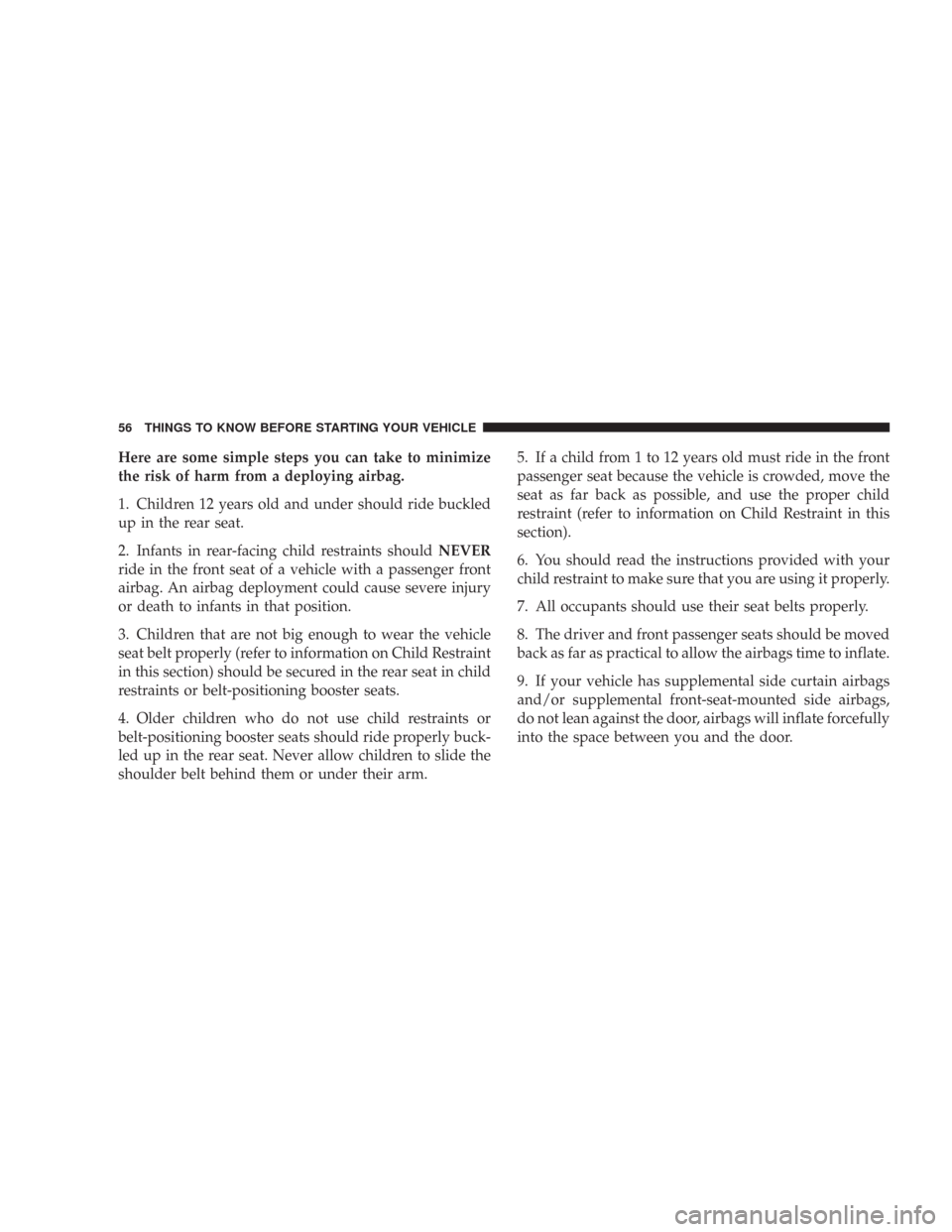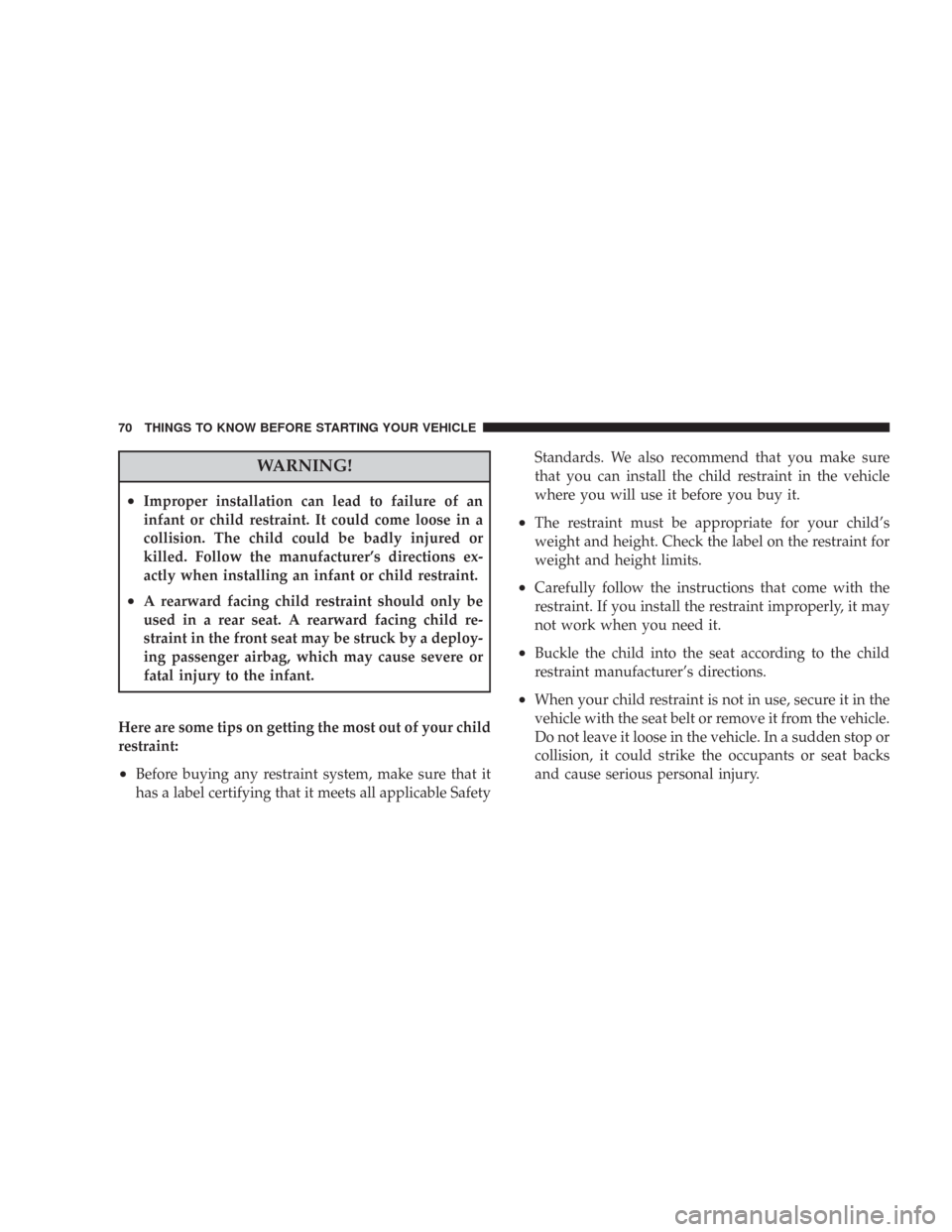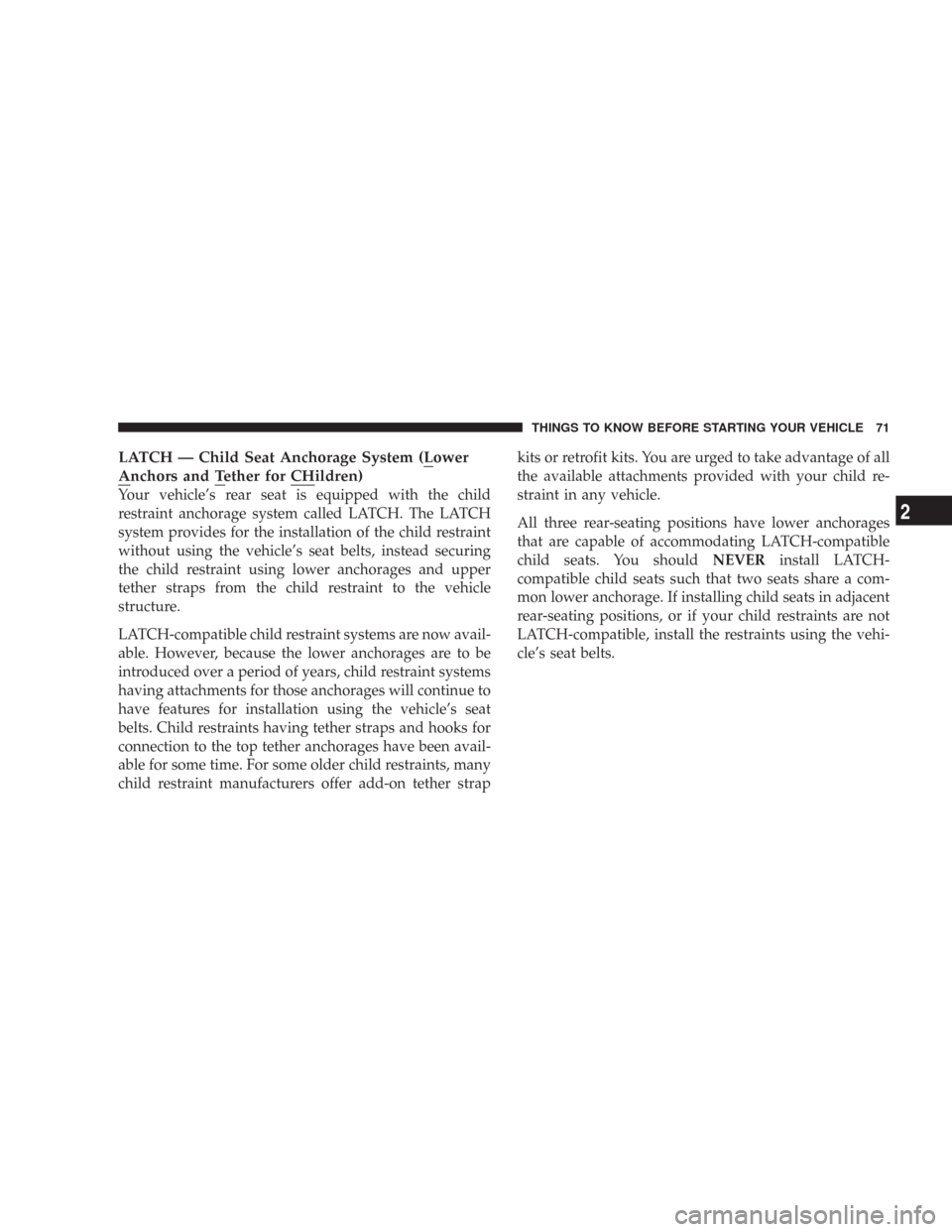Page 24 of 519

Sound Horn with Remote Key Lock
This feature will cause the horn to chirp when the doors
are locked with the transmitter. This feature can be
turned on or turned off. To change the current setting,
proceed as follows:
•For vehicles equipped with the Electronic Vehicle
Information Center (EVIC), refer to “Sound Horn with
Remote Key Lock,” under “Personal Settings (Cus-
tomer Programmable Features),” under “Electronic
Vehicle Information Center (EVIC)” in Section 4 of this
manual for details.
•For vehicles not equipped with the EVIC, perform the
following steps:
1. Press the LOCK button on a programmed transmitter
for at least 4 seconds, but no longer than 10 seconds.
Then, press the PANIC button while still holding the
LOCK button.2. Release both buttons at the same time.
3. Test the feature while outside of the vehicle, by
pressing the LOCK button on the transmitter with the
ignition switch in the LOCK position, and the key
removed.
4. Repeat these steps if you want to return this feature to
its previous setting.
NOTE:Pressing the LOCK button on the transmitter
while you are in the vehicle will activate the Security
Alarm. Opening a door with the Security Alarm activated
will cause the alarm to sound. Press the UNLOCK button
to deactivate the Security Alarm.
To unlatch the trunk:
Press the trunk button on the transmitter two times
within 5 seconds to unlatch the trunk.
24 THINGS TO KNOW BEFORE STARTING YOUR VEHICLE
Page 27 of 519

If your Remote Keyless Entry (RKE) transmitter fails to
operate from a normal distance, check for these two
conditions.
1. A weak battery in the transmitter. The expected life of
the battery is a minimum of three years.
2. Closeness to a radio transmitter such as a radio station
tower, airport transmitter, and some mobile or CB radios.
REMOTE STARTING SYSTEM — IF EQUIPPED
This system uses the Remote Keyless Entry (RKE) trans-
mitter to start the engine conveniently from outside the
vehicle while still maintaining security. The system has a
targeted range of 328 ft. (100 m).
NOTE:The vehicle must be equipped with an auto-
matic transmission to be equipped with Remote Start.
How To Use Remote Start
All of the following conditions must be met before the
engine will remote start:
•Gear selector lever in “P” (Park).
•Doors closed.
•Hood closed.
•Trunk closed.
•Hazard switch off.
•Brake switch inactive (brake pedal not pressed).
•Ignition key removed from ignition switch.
•Battery at an acceptable charge level.
•RKE Panic button not pressed.
THINGS TO KNOW BEFORE STARTING YOUR VEHICLE 27
2
Page 28 of 519

To Enter Remote Start Mode
Press and release the Remote Start button on
the RKE transmitter twice within 5 seconds.
The parking lights will flash and horn will
honk twice (if programmed). Then, the engine
will start and the vehicle will remain in the Remote Start
mode for a 15-minute cycle.
NOTE:
•The park lamps will turn on and remain on during
Remote Start mode.
•For security, power window and power sunroof op-
eration (if so equipped) is disabled when the vehicle is
in the Remote Start mode.
•The engine can be started two consecutive times (two
15-minute cycles) with the RKE transmitter. However,
the ignition switch must be cycled to the ON position
before you can repeat the start sequence for a third
cycle.
To Exit Remote Start Mode without Driving the
Vehicle
Allow the engine to run for the entire 15-minute cycle.
To Exit Remote Start Mode & Drive the Vehicle
Before the end of the 15-minute cycle, press and release
the UNLOCK button on the RKE transmitter to unlock
the doors and disarm the Vehicle Security Alarm (if
equipped). Then, prior to the end of the 15-minute cycle,
insert the key into the ignition switch and turn the switch
to the ON position.
NOTE:The ignition switch must be in the ON position
in order to drive the vehicle.
To Turn Off the Engine While in Remote Start
Mode
Press and release the remote start button one time.
28 THINGS TO KNOW BEFORE STARTING YOUR VEHICLE
Page 30 of 519
WARNING!
•For personal security and safety in the event of an
accident, lock the vehicle doors as you drive as
well as when you park and leave the vehicle.
•When leaving the vehicle, always remove the key
from the ignition, and lock your vehicle. Unsuper-
vised use of vehicle equipment may cause severe
personal injuries and death.
•Never leave children alone in a vehicle. Leaving
children in a vehicle unattended is dangerous for a
number of reasons. A child or others could be
seriously or fatally injured. Don’t leave the keys in
the ignition. A child could operate power win-
dows, other controls, or move the vehicle.
Power Door Locks
A power door lock switch is on each front door trim
panel. Use this switch to lock or unlock the doors.
If you press the power door lock switch while the key is
in the ignition, and any front door is open, the power
Power Door Lock Switch
30 THINGS TO KNOW BEFORE STARTING YOUR VEHICLE
Page 56 of 519

Here are some simple steps you can take to minimize
the risk of harm from a deploying airbag.
1. Children 12 years old and under should ride buckled
up in the rear seat.
2. Infants in rear-facing child restraints shouldNEVER
ride in the front seat of a vehicle with a passenger front
airbag. An airbag deployment could cause severe injury
or death to infants in that position.
3. Children that are not big enough to wear the vehicle
seat belt properly (refer to information on Child Restraint
in this section) should be secured in the rear seat in child
restraints or belt-positioning booster seats.
4. Older children who do not use child restraints or
belt-positioning booster seats should ride properly buck-
led up in the rear seat. Never allow children to slide the
shoulder belt behind them or under their arm.5. If a child from 1 to 12 years old must ride in the front
passenger seat because the vehicle is crowded, move the
seat as far back as possible, and use the proper child
restraint (refer to information on Child Restraint in this
section).
6. You should read the instructions provided with your
child restraint to make sure that you are using it properly.
7. All occupants should use their seat belts properly.
8. The driver and front passenger seats should be moved
back as far as practical to allow the airbags time to inflate.
9. If your vehicle has supplemental side curtain airbags
and/or supplemental front-seat-mounted side airbags,
do not lean against the door, airbags will inflate forcefully
into the space between you and the door.
56 THINGS TO KNOW BEFORE STARTING YOUR VEHICLE
Page 67 of 519

•Cruise control status
•Traction/stability control status
•Tire pressure monitoring system status (if equipped)
Child Restraint
Everyone in your vehicle needs to be buckled up all the
time — babies and children, too. Every state in the United
States and all Canadian provinces require that small
children ride in proper restraint systems. This is the law,
and you can be prosecuted for ignoring it.
Children 12 years and under should ride properly buck-
led up in a rear seat, if available. According to crash
statistics, children are safer when properly restrained in
the rear seats rather than in the front.
WARNING!
In a collision, an unrestrained child, even a tiny baby,
can become a missile inside the vehicle. The force
required to hold even an infant on your lap could
become so great that you could not hold the child, no
matter how strong you are. The child and others
could be badly injured. Any child riding in your
vehicle should be in a proper restraint for the child’s
size.
THINGS TO KNOW BEFORE STARTING YOUR VEHICLE 67
2
Page 70 of 519

WARNING!
•Improper installation can lead to failure of an
infant or child restraint. It could come loose in a
collision. The child could be badly injured or
killed. Follow the manufacturer’s directions ex-
actly when installing an infant or child restraint.
•A rearward facing child restraint should only be
used in a rear seat. A rearward facing child re-
straint in the front seat may be struck by a deploy-
ing passenger airbag, which may cause severe or
fatal injury to the infant.
Here are some tips on getting the most out of your child
restraint:
•Before buying any restraint system, make sure that it
has a label certifying that it meets all applicable SafetyStandards. We also recommend that you make sure
that you can install the child restraint in the vehicle
where you will use it before you buy it.
•The restraint must be appropriate for your child’s
weight and height. Check the label on the restraint for
weight and height limits.
•Carefully follow the instructions that come with the
restraint. If you install the restraint improperly, it may
not work when you need it.
•Buckle the child into the seat according to the child
restraint manufacturer’s directions.
•When your child restraint is not in use, secure it in the
vehicle with the seat belt or remove it from the vehicle.
Do not leave it loose in the vehicle. In a sudden stop or
collision, it could strike the occupants or seat backs
and cause serious personal injury.
70 THINGS TO KNOW BEFORE STARTING YOUR VEHICLE
Page 71 of 519

LATCH — Child Seat Anchorage System (Lower
Anchors and Tether for CHildren)
Your vehicle’s rear seat is equipped with the child
restraint anchorage system called LATCH. The LATCH
system provides for the installation of the child restraint
without using the vehicle’s seat belts, instead securing
the child restraint using lower anchorages and upper
tether straps from the child restraint to the vehicle
structure.
LATCH-compatible child restraint systems are now avail-
able. However, because the lower anchorages are to be
introduced over a period of years, child restraint systems
having attachments for those anchorages will continue to
have features for installation using the vehicle’s seat
belts. Child restraints having tether straps and hooks for
connection to the top tether anchorages have been avail-
able for some time. For some older child restraints, many
child restraint manufacturers offer add-on tether strapkits or retrofit kits. You are urged to take advantage of all
the available attachments provided with your child re-
straint in any vehicle.
All three rear-seating positions have lower anchorages
that are capable of accommodating LATCH-compatible
child seats. You shouldNEVERinstall LATCH-
compatible child seats such that two seats share a com-
mon lower anchorage. If installing child seats in adjacent
rear-seating positions, or if your child restraints are not
LATCH-compatible, install the restraints using the vehi-
cle’s seat belts.
THINGS TO KNOW BEFORE STARTING YOUR VEHICLE 71
2